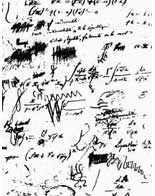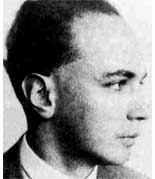![][1]
Classical Brauer-Severi varieties can be described either as twisted
forms of projective space (Severi\’s way) or as varieties containing
splitting information about central simple algebras (Brauer\’s way). If
$K$ is a field with separable closure $\overline{K}$, the first approach
asks for projective varieties $X$ defined over $K$ such that over the
separable closure $X(\overline{K}) \simeq
\mathbb{P}^{n-1}_{\overline{K}}$ they are just projective space. In
the second approach let $\Sigma$ be a central simple $K$-algebra and
define a variety $X_{\Sigma}$ whose points over a field extension $L$
are precisely the left ideals of $\Sigma \otimes_K L$ of dimension $n$.
This variety is defined over $K$ and is a closed subvariety of the
Grassmannian $Gr(n,n^2)$. In the special case that $\Sigma = M_n(K)$ one
can use the matrix-idempotents to show that the left ideals of dimension
$n$ correspond to the points of $\mathbb{P}^{n-1}_K$. As for any central
simple $K$-algebra $\Sigma$ we have that $\Sigma \otimes_K \overline{K}
\simeq M_n(\overline{K})$ it follows that the varieties $X_{\Sigma}$ are
among those of the first approach. In fact, there is a natural bijection
between those of the first approach (twisted forms) and of the second as
both are classified by the Galois cohomology pointed set
$H^1(Gal(\overline{K}/K),PGL_n(\overline{K}))$ because
$PGL_n(\overline{K})$ is the automorphism group of
$\mathbb{P}^{n-1}_{\overline{K}}$ as well as of $M_n(\overline{K})$. The
ringtheoretic relevance of the Brauer-Severi variety $X_{\Sigma}$ is
that for any field extension $L$ it has $L$-rational points if and only
if $L$ is a _splitting field_ for $\Sigma$, that is, $\Sigma \otimes_K L
\simeq M_n(\Sigma)$. To give one concrete example, If $\Sigma$ is the
quaternion-algebra $(a,b)_K$, then the Brauer-Severi variety is a conic
$X_{\Sigma} = \mathbb{V}(x_0^2-ax_1^2-bx_2^2) \subset \mathbb{P}^2_K$
Whenever one has something working for central simple algebras, one can
_sheafify_ the construction to Azumaya algebras. For if $A$ is an
Azumaya algebra with center $R$ then for every maximal ideal
$\mathfrak{m}$ of $R$, the quotient $A/\mathfrak{m}A$ is a central
simple $R/\mathfrak{m}$-algebra. This was noted by the
sheafification-guru [Alexander Grothendieck][2] and he extended the
notion to Brauer-Severi schemes of Azumaya algebras which are projective
bundles $X_A \rightarrow \mathbf{max}~R$ all of which fibers are
projective spaces (in case $R$ is an affine algebra over an
algebraically closed field). But the real fun started when [Mike
Artin][3] and [David Mumford][4] extended the construction to suitably
_ramified_ algebras. In good cases one has that the Brauer-Severi
fibration is flat with fibers over ramified points certain degenerations
of projective space. For example in the case considered by Artin and
Mumford of suitably ramified orders in quaternion algebras, the smooth
conics over Azumaya points degenerate to a pair of lines over ramified
points. A major application of their construction were examples of
unirational non-rational varieties. To date still one of the nicest
applications of non-commutative algebra to more mainstream mathematics.
The final step in generalizing Brauer-Severi fibrations to arbitrary
orders was achieved by [Michel Van den Bergh][5] in 1986. Let $R$ be an
affine algebra over an algebraically closed field (say of characteristic
zero) $k$ and let $A$ be an $R$-order is a central simple algebra
$\Sigma$ of dimension $n^2$. Let $\mathbf{trep}_n~A$ be teh affine variety
of _trace preserving_ $n$-dimensional representations, then there is a
natural action of $GL_n$ on this variety by basechange (conjugation).
Moreover, $GL_n$ acts by left multiplication on column vectors $k^n$.
One then considers the open subset in $\mathbf{trep}_n~A \times k^n$
consisting of _Brauer-Stable representations_, that is those pairs
$(\phi,v)$ such that $\phi(A).v = k^n$ on which $GL_n$ acts freely. The
corresponding orbit space is then called the Brauer-Severio scheme $X_A$
of $A$ and there is a fibration $X_A \rightarrow \mathbf{max}~R$ again
having as fibers projective spaces over Azumaya points but this time the
fibration is allowed to be far from flat in general. Two months ago I
outlined in Warwick an idea to apply this Brauer-Severi scheme to get a
hold on desingularizations of quiver quotient singularities. More on
this next time.
[1]: http://www.neverendingbooks.org/DATA/brauer.jpg
[2]: http://www-gap.dcs.st-and.ac.uk/~history/Mathematicians/Grothendieck.html
[3]: http://www.cirs-tm.org/researchers/researchers.php?id=235
[4]: http://www-gap.dcs.st-and.ac.uk/~history/Mathematicians/Mumford.html
[5]: http://alpha.luc.ac.be/Research/Algebra/Members/michel_id.html
 Last time we have seen that in order to classify all
Last time we have seen that in order to classify all Non-commutative geometry seems pretty trivial compared
Non-commutative geometry seems pretty trivial compared